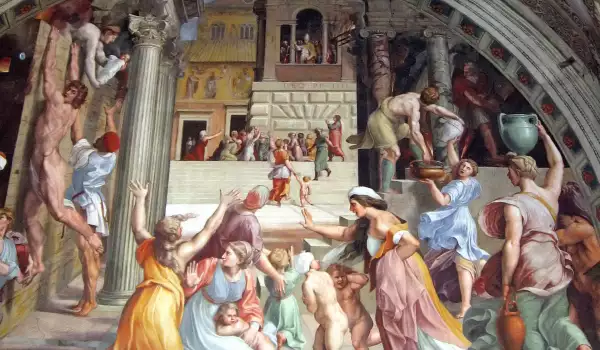Sistine Chapel

Sistine Chapel is part of the Catholic complex of the Vatican, the chief monument of the Apostolic Palace and official residence by the Catholic Pope in the Vatican. Known for its architecture and unsurpassed interior decoration, the Sistine Chapel is the result of the enormous work of great Renaissance artists like Michelangelo, Raphael, Bernini, and Sandro Botticelli. One of the highest achievements of Michelangelo Bonaroti and actually hi best work on a ceiling frescoe, is the ceiling of the Sistine Chapel.
Sistine Chapel was built between 1473 and 1484, by order of Pope Sistus IV, after whom this Catholic and Church was named. The first mass is served in the chapel on August 9, 1483. In the Sistine Chapel sits the papal conclave where they elect a new pope. That is why the roof of the chapel has a chimney. White smoke in the chimney means that the new pope was elected, and black - the choice is still unclear and misguided. The onclave sits behind a locked door and do not leave the room until they select the name of the new Pope.
Sistine Chapel is rectangular and its dimensions reach 40.93 meters in length and width of the temple at 13.41 meters. The height of the Sistine Chapel is 20.70 meters. According to the Old Testament those are the dimensions of the Temple of Solomon. The main chapel is divided into two parts, the smaller is for believers, but the greater and more extensive part includes the altar and there is where they perform their religious ceremonies.

Once upon a time, the cancellata was made of gilded iron and was located more centrally, but had to be moved to allow more space for the Pope. Earlier, during special ceremonies, the walls of the Sistine Chapel were covered with beautiful tapestries depicting biblical scenes, commissioned by Raphael himself. They are scattered across Europe after the French army plundered them.
Especially popular is the beautiful Sistine Chapel with its frescoes and murals. Most murals are generally divided into three stages - before the Ten Commandments given to Moses, between Moses and the birth of Christ and the Christian era. They were painted in a very short period of time from July 1481 to May 1482, by recreating scenes from the life of Moses and Christ from the Old and New Testament.
Each stage of the two cycles is thematically linked, the Old and New Testament are considered indivisible. Particularly striking are the pictures in which Christ gave the keys to St. Peter and the Punishment of the Quran. In both works in the background stands the triumphal arch of Constantine, who was the 1st Christian emperor. The pope gave temporary authority over the Roman western world.
Undoubtedly the most remarkable in the Sistine Chapel are the frescoes which took over four years to make, from the genius Michelangelo. According to one theory, Michelangelo had to paint the interior of the temple, because he was the victim of a plot by the architect Donato Bramante and the painter Raphael. The two were close friends with Leonardo da Vinci and wanted to incapacitate his rival sculptor Michelangelo, and recommend him for a major task of painting. Initially, Michelangelo wanted to refuse the work, in favor of Raphael, but was forced to take on the task at the urging of Pope Julius II.

His performance had a huge impact on the work of Raphael. He ruined his own paintings when he saw the masterpieces of his rival. In 1508 Michelangelo was employed by Pope Julius II to paint the ceiling of the Sistine Chapel. When work is completed in 1512, the ceiling of the Sistine Chapel has 343 human images and shapes.
Initially, Michelangelo was employed to paint only 12 figures – the Twelve Apostles. He painted the creation of Adam and Eve in the Garden of Eden and Noah’s Flood. He used only male models, even for the female characters, because female models are very hard to find and were very expensive. Other frescoes are the biblical scenes "Separation of light from darkness, " "Separation of water from land, " "Fall" and others.















